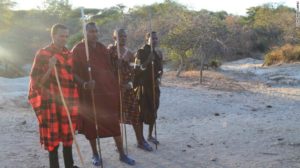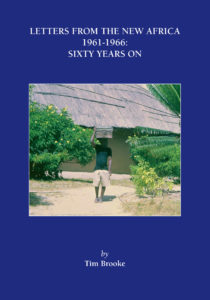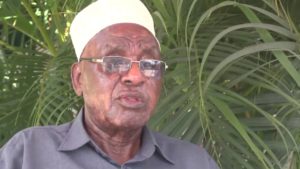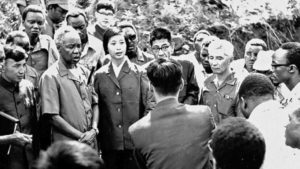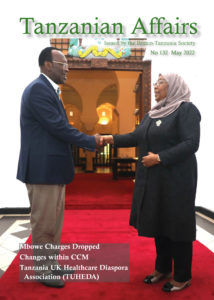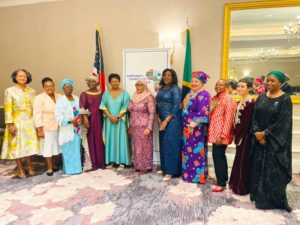by Donovan McGrath
‘I stumbled across it’: the push to help Tanzania’s untapped football talent
(Guardian UK – online) Michael Noone went to Africa looking for a change and now has an academy for boys and girls in one of Tanzania’s poorest areas. Extract continues: When Michael Noone set off on his solo walk from Old Trafford to Wembley Stadium … to raise money for his football academy in Tanzania, it wasn’t the first time he had taken a journey into the unknown. A youth coach with experience of working in schools in Manchester, the United States and Canada, the 37-year-old was “looking for a change in my life” when he arrived in east Africa in March 2020. “I just kind of stumbled across it,” he says. “I came over with just a backpack and had nothing organised so I sort of just wandered around. I started volunteering in this orphanage, joined in a few games and found the football culture unbelievable. I’ve been coaching for many years and I’d played with some guys from east Africa before and they told me that there was so much hugely untapped talent here… Noone started coaching a group of players in Mivumoni, a small town about 300km north of Dar es Salaam in one of Tanzania’s poorest regions. He was so impressed with the standard that he set up the Route One Academy, which caters for 150 boys and girls from under-eights to under-18s. “Every week there were more and more who kept joining our group,” he says. “What started off as something casual has ended up with me wanting to stay and help.” … Noone adds: “My aim is now to try and improve that environment and showcase the ability that these players have. The skill levels here are really high… Mbwana Samatta’s short spell at Aston Villa in 2020 made him the first Tanzanian to play in the Premier League but Noone believes there is every chance plenty more could come if local players are given the right opportunities… (23 June 2022)
Meet Tanzania’s Lion Defenders: the hunters-turned-conservationists of the Barabaig tribe
(CNN USA – online) Extract: There are 18 Lion Defenders in Ruaha. They monitor local lion populations and help to implement safe herding practices and fortify livestock enclosures. Lion Landscapes also provides technology to improve the safety of tribal communities as lion populations recover… Tracking and monitoring big cats through smartphones helps the lion populations to grow without increased risk to tribespeople… According to Lion Landscapes, since it began its work the killing of lions has decreased by more than 70% in the area of Ruaha National Park in which it operates. The Barabaig tribe in Ruaha National Park, Tanzania traditionally hunted lions that endangered their community – but with populations of the big cat dwindling, Barabaig warriors have become their protectors. Tanzania is home to roughly 50% of the lion population in sub-Saharan Africa, and around 800 of those lions live in Ruaha National Park. Many people in sub-Saharan Africa live in conflict with lions… In Ruaha National Park, warriors working with Lion Landscapes are known as “Lion Defenders.” The role is usually given to young hunters with good knowledge of the area and a comprehensive understanding of lion behaviour and how to track them… They monitor local lion populations and help to implement safe herding practices and fortify livestock enclosures… “The challenges Lion Defenders face is with some people in the community who are not in support of the project,” … says [Stephano Asecheka, who is from the Barabaig tribe]… According to Asecheka, taking tribespeople on tours in Ruaha National Park endears the community to the lions and helps them understand the value of the animals as a tourist draw that can boost the local economy. “They feel a sense of ownership and get to understand the right reasons to why we are protecting the lions,” he explains… (21 April 2022)
Rats to the rescue: Rodents are being trained to go into earthquake debris wearing backpacks with microphones so rescue teams can talk to survivors
(Daily Mail UK – online) Extract: Scientists are training rats to find earthquake survivors while wearing tiny backpacks with inbuilt microphones so rescue teams can locate and speak with them. Research scientist Dr Donna Kean, 33, from Glasgow, has been working in Morogoro, Tanzania over the past year for non-profit organisation APOPO on the project titled ‘Hero Rats’… Kean said: ‘Rats would be able to get into small spaces to get to victims buried in rubble… The rodents are trained to respond to a beep, which calls them back to the base… ‘We have the potential to speak to victims through the rat,’ Kean added… So far seven rats have been trained… (3 June 2022)
Greener pastures: Can ancient ecoengineering help fix our degraded landscapes?
(CNN USA – online) Extract: By removing trees and installing cell bunding – which creates water-tight pockets – Northern Ireland Water tried to determine if bunding could restore peatland, which naturally filters the country’s drinking water… Northern Ireland Water is already implementing cell bunding elsewhere… Bunds are simple structures that have been used for thousands of years to keep liquid in or out… The most basic consists of mounded earth. In terms of geoengineering, they’re about as low-tech as it comes, but when built strategically, their impact on the environment can be profound. Separate programs in as disparate climates as Tanzania and Northern Ireland are demonstrating bunding’s regenerative power – and the results could benefit both humans and nature. In Tanzania, a collaboration between non-profits Justdiggit and the LEAD Foundation is working with local communities to dig tens of thousands of bunds on arid land to harvest rainwater, as part of a massive regenerative effort backed by the UN. Angelina Tarimo, a coordinator at the LEAD Foundation, has been working with local communities in places such as Pembamoto, village in the Dodoma region, where desertification is a growing threat… Semi-circular shaped bunds trap water running off the ground and allow it to penetrate the earth. Grass seed sown inside the bunds grows, and over time greenery extends beyond the bund. Agriculture has had a negative impact on land in Tanzania, Tarimo says, with farmers clearing trees and native plants in order to grow crops, or allowing grassland to become overgrazed. This damages the soil structure and makes it more prone to erosion. As the ground is drier, when rain falls it is more likely water will run off the surface instead of infiltrating the ground, washing away fertile soil and perpetuating a drying cycle… Between sites in Tanzania and southern Kenya, over 200,000 bunds have been dug to date… (18 July 2022)
British hotelier locked up in Zanzibar ‘hell hole’ prison and his wife are freed after judge throws out money laundering charges
(Daily Mail UK – online) Extract: … The couple [Simon Woods and Francesca Scalfari], who run the four-star Sharazad Boutique Hotel in Zanzibar, faced 20 years in jail over money laundering charges after they fell out with two investors who had invested in their hotel. Police shaved Simon’s head when he was taken into custody before putting him in a cell with 200 other dangerous inmates, including murderers, at the Kilimani Prison, Wood’s family said… They also said the couple, who have lived on the island for 20 years, were denied basic needs – including access to water – and relatives weren’t allowed into the jail to see them on several occasions… (23 June 2022)
Tanzania identifies deadly outbreak of mystery disease as leptospirosis
(ABC News USA – online) Extract: A deadly outbreak of an unknown disease in Tanzania has been identified as leptospirosis, health officials said. More than 20 cases, including three deaths, have been reported in the southern Lindi region, with patients exhibiting symptoms similar to Ebola or Marburg virus diseases – fever, headache, fatigue and bleeding, especially from the nose, according to health officials. Preliminary results from laboratory testing … ruled out Ebola and Marburg viruses as well as COVID-19, making the illness a mystery – until now. Tanzanian Health Minister Ummy Mwalimu announced at a press conference … that samples from patients tested positive for leptospirosis, an infectious bacterial disease that affects both animals and humans. “I would like to inform the public that sample testing from patients has confirmed the outbreak is leptospirosis field fever or ‘homa ya Mgunda’ as it is known in Swahili,” Mwalimu said… Leptospirosis is transmitted directly or indirectly from animals to humans, mainly when people come into contact with the urine of infected animals or a urine-contaminated environment… Human-to-human transmission is rare, according to the WHO… (20 July 2022)
Why women in Tanzania face jail when their naked pictures are leaked to social media
(ITV UK – online) Extract: Mobile phone use in Tanzania has rocketed over the past 10 years, mostly due to the availability of cheaper smartphones. Millions in the East African nation have grown used to socialising, banking and learning wherever they want – but Asha Abinallah feels “lucky” she came of age before the smartphone boom. As connectivity increases, so does the amount of people seeking help from Ms Abinallah’s organisation, complaining they’ve had naked pictures leaked without their consent. The subjects are overwhelmingly young, female, “naïve and in love”, Ms Abinallah, head of digital empowerment organisation Women at Web explains. “But the perpetrators are usually people they love.” For victims of non-consensual intimate image abuse, consequences can include isolation, suicide and even a criminal conviction. Strict anti-pornography laws introduced in 2016 mean publishing pornography online, or “causing” it to be published, is punishable by a fine of not less than 20 million Tanzanian shillings (around £6,900) or at least three years in jail. Thanks to the liberal interpretation of the law, there’s a trend of [the women] being punished, rather than the person who leaked [the images]… (26 May 2022)
In Tanzania, karate classes imbues vigour in people with albinism
(Al Jazeera Qatar/UK/USA – online) Extract: Now that he’s learned to fight, Hassan Farahani doesn’t feel the need to do so anymore. “When people make jokes or harass me in the street, now I just leave. I have the confidence of martial arts—my strength is here,” he says, gesturing towards his chest. Farahani, 29, is part of a group of Tanzanians with albinism learning karate in Dar es Salaam, their country’s largest city… Their goal is not just to learn self-defence, but to one day become karate instructors themselves, teaching future generations of Tanzanians with albinism about karate, discipline, and self-confidence… In Tanzania, an estimated 1 in 1,400 people in the country have albinism, compared to a rate of about 1 in 20,000 in the United States. So people with the condition there are subject of daily discrimination with their light skin instantly setting them apart as targets. Myths and superstitions surrounding Tanzanians with albinism: that they are immortal, that they aren’t human but instead ghosts, or that they are cursed by a deity. Many have been attacked, mutilated and even killed for their body parts, which are believed to hold magical powers. Witchdoctors use these body parts for potions and spells meant to heal sickness, grant political power or bestow wealth and success… The training programme was founded by Jerome Mgahama, a karate instructor for over 20 years and founder of the Japanese Karate Association club in Dar es Salaam… He was inspired to start it after demonstrating martial arts for children with albinism at summer camps organized by NGOs and religious groups in Tanzania… (8 July 2022)
Visiting Dignitary: Mission Creep
(The New Yorker – USA) Extract: Mission: Her Excellency Samia Suluhu Hassan, the sixth President of the United Republic of Tanzania, and its first female head of state, desires a stroll through Central Park. Objective: To correct certain impressions advanced by Hassan’s predecessor, John Magufuli (nickname: the Bulldozer), who largely closed off Tanzania to the rest of the world and whose COVID strategy centered on three days of national prayer, after which he proclaimed, “The Corona disease has been eliminated thanks to God.” … Hassan, who was vaccinated publicly, is on a good-will tour of the United States, declaring Tanzania again open to visitors, investors, and science. … [S]he attended a summit with Kamala Harris. In New York, she will appear at the premiere of “The Royal Tour,” a PBS program in which Hassan guides the host, Peter Greenberg, around her country for nine days—Zanzibar, Serengeti, Ngorongoro, Kilimanjaro. She hopes to attract American tourists… (16 May 2022) – Editor: Thanks to Elsbeth Court for this item.
Award given to UN Biodiversity Chief
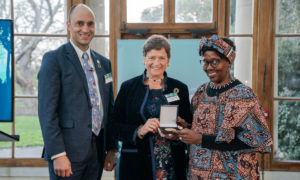
Alexandre Antonelli, Kew’s Director of Science and Chair of the Trustees, Dame Amelia Fawcett, awarding Elizabeth Maruma Mrema with the Kew International Medal – RBG Kew
(Kew Magazine – UK) Extract: Elizabeth Maruma Mrema, the Executive Secretary of the United Nations Convention on Biological Diversity (CBD) has been awarded the 15th Kew International Medal for her vital work in championing the importance of biodiversity conservation… For over two decades, Elizabeth, a Tanzanian biodiversity leader and lawyer, has held various positions at the UN Environment Program (UNEP) focusing on environmental laws. She will be leading efforts to secure ambition and agreement on a critical new framework for halting biodiversity loss and promoting sustainable development at the UN Biodiversity Conference, COP15, later this year. In a keynote lecture at Kew to accept the award, she highlighted the importance of plant science in finding solutions to urgent crises in nature. ‘Biodiversity loss is our shared burden. It’s also our shared responsibility,’ said Elizabeth. (Summer 2022) Thanks to Elsbeth Court for this item – Editor
Record-breaking Tanzanian ruby exposed in Dubai
(Africa News Republic of Congo/France – online) Extract: The magnificent gemstone which weighs 2.8 kilograms was presented to the public for the first time … in Dubai…. According to mineral experts, the greenish and purplish stone could be auctioned for 120 million dollars. In Africa, Kenya, Mozambique and Tanzania are one of the main ruby producing countries… (17 April 2022)

